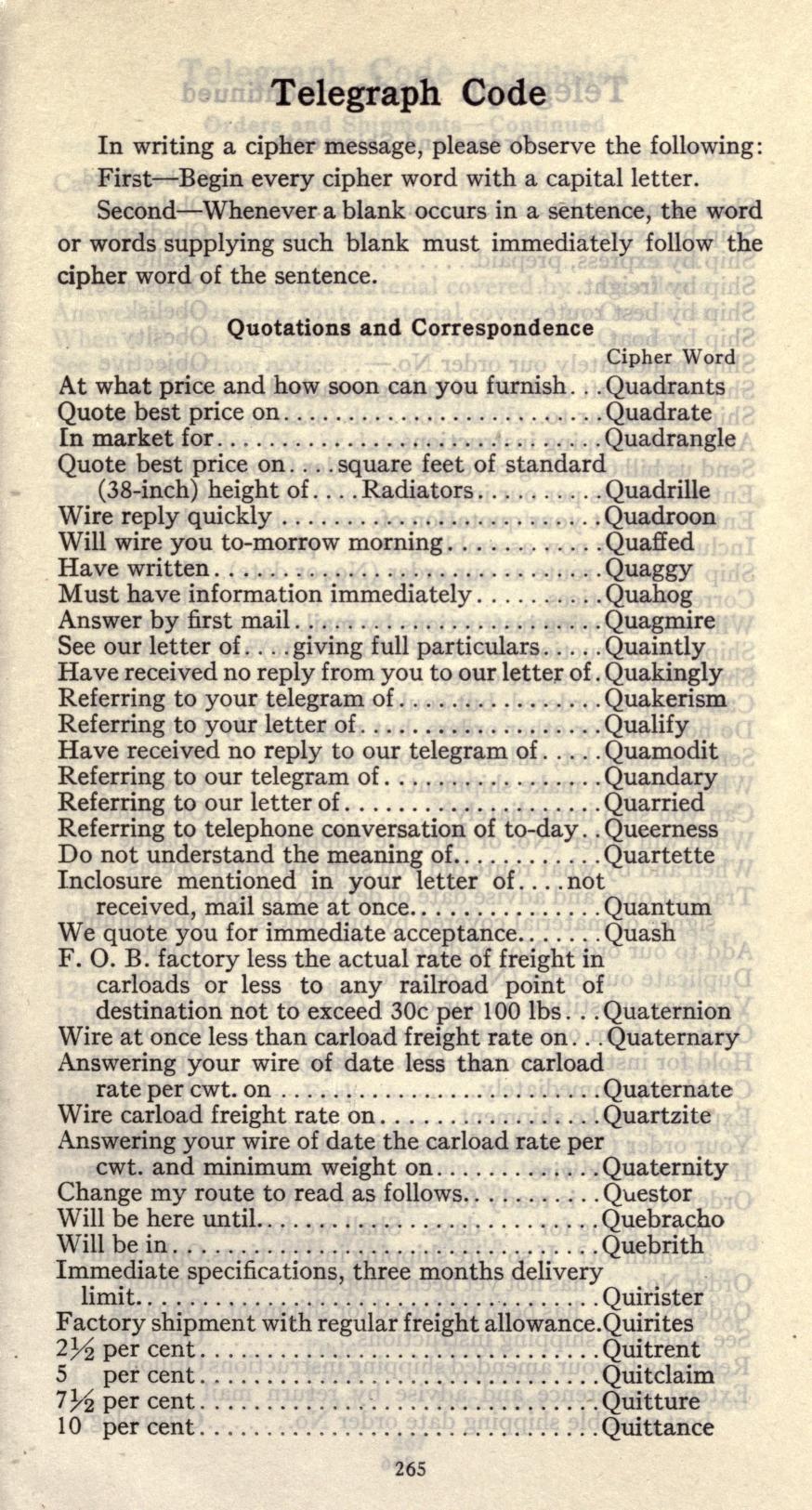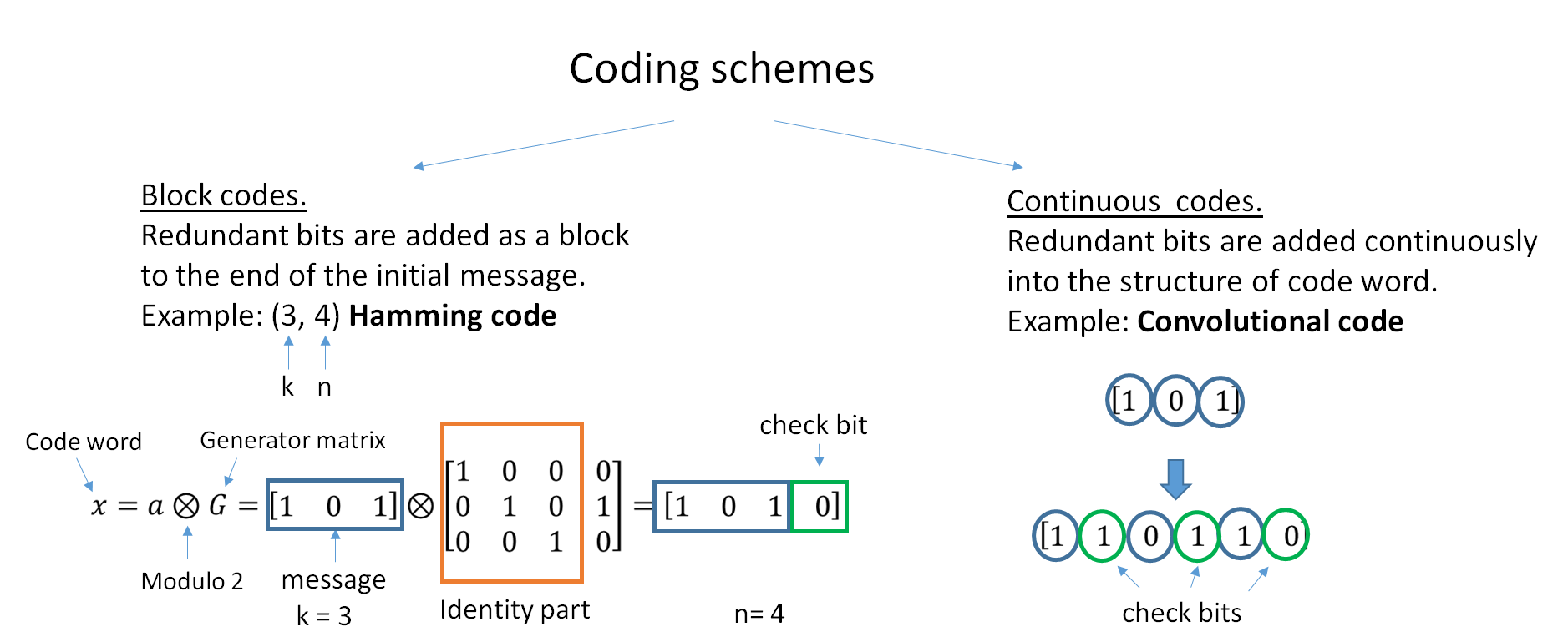|
Acme Commodity And Phrase Code
''Acme Commodity and Phrase Code'' is a codebook providing the general-purpose Commercial code (communications), commercial telegraph code known as the ''Acme Code''. It was published in 1923 by the Acme Code Company. The book provides a listing of condensed terms and codes used to shorten telegrams and save money. The book was extremely popular amongst businesses in the 1930s. This code was one of the few telegram codes permitted by the Allied powers during the Second World War. Description The ''Acme'' code consists of one hundred thousand five letter codes each intended to stand in for a phrase. It was designed to be tolerant of Transcription_error#Transposition_error, transposition errors; the author claims that "no transposition of any two adjoining letters will make another word in the book". However, as later discovered by J. Reeds, the code did not provide this level of error correction, containing at least eleven pairs of words differing only by the transposition o ... [...More Info...] [...Related Items...] OR: [Wikipedia] [Google] [Baidu] |
Codebook
A codebook is a type of document used for gathering and storing cryptography codes. Originally codebooks were often literally , but today codebook is a byword for the complete record of a series of codes, regardless of physical format. Cryptography In cryptography, a codebook is a document used for implementing a code. A codebook contains a lookup table for coding and decoding; each word or phrase has one or more strings which replace it. To decipher messages written in code, corresponding copies of the codebook must be available at either end. The distribution and physical security of codebooks presents a special difficulty in the use of codes, compared to the secret information used in ciphers, the key, which is typically much shorter. The United States National Security Agency documents sometimes use ''codebook'' to refer to block ciphers; compare their use of ''combiner-type algorithm'' to refer to stream ciphers. Codebook come in two forms, one-part or two-part: * In o ... [...More Info...] [...Related Items...] OR: [Wikipedia] [Google] [Baidu] |
Commercial Code (communications)
In telecommunication, a commercial code is a code once used to save on cablegram costs. Telegraph (and telex) charged per word sent, so companies which sent large volumes of telegrams developed codes to save money on tolls. Elaborate commercial codes which encoded complete phrases into single words were developed and published as codebooks of thousands of phrases and sentences with corresponding codewords. Commercial codes were not generally intended to keep telegrams private, as codes were widely published; they were usually cost-saving measures only. Many general-purpose codes, such as the ''Acme Code'' and the ''ABC Code'', were published and widely used between the 1870s and the 1950s, before the arrival of transatlantic telephone calls and next-day airmail rendered them obsolete. Numerous special-purpose codes were also developed and sold for fields as varied as aviation, car dealerships, insurance, and cinema, containing words and phrases commonly used in those professions. ... [...More Info...] [...Related Items...] OR: [Wikipedia] [Google] [Baidu] |
Codes
In communications and information processing, code is a system of rules to convert information—such as a letter, word, sound, image, or gesture—into another form, sometimes shortened or secret, for communication through a communication channel or storage in a storage medium. An early example is an invention of language, which enabled a person, through speech, to communicate what they thought, saw, heard, or felt to others. But speech limits the range of communication to the distance a voice can carry and limits the audience to those present when the speech is uttered. The invention of writing, which converted spoken language into visual symbols, extended the range of communication across space and time. The process of encoding converts information from a source into symbols for communication or storage. Decoding is the reverse process, converting code symbols back into a form that the recipient understands, such as English or/and Spanish. One reason for coding is to ena ... [...More Info...] [...Related Items...] OR: [Wikipedia] [Google] [Baidu] |
Telegrams
Telegraphy is the long-distance transmission of messages where the sender uses symbolic codes, known to the recipient, rather than a physical exchange of an object bearing the message. Thus flag semaphore is a method of telegraphy, whereas pigeon post is not. Ancient signalling systems, although sometimes quite extensive and sophisticated as in China, were generally not capable of transmitting arbitrary text messages. Possible messages were fixed and predetermined and such systems are thus not true telegraphs. The earliest true telegraph put into widespread use was the optical telegraph of Claude Chappe, invented in the late 18th century. The system was used extensively in France, and European nations occupied by France, during the Napoleonic era. The electric telegraph started to replace the optical telegraph in the mid-19th century. It was first taken up in Britain in the form of the Cooke and Wheatstone telegraph, initially used mostly as an aid to railway signalling. Thi ... [...More Info...] [...Related Items...] OR: [Wikipedia] [Google] [Baidu] |
Transcription Error
A transcription error is a specific type of data entry error that is commonly made by human operators or by optical character recognition (OCR) programs. Human transcription errors are commonly the result of typographical mistakes; putting one’s fingers in the wrong place while touch typing is the easiest way to make this error. Electronic transcription errors occur when the scan of some printed matter is compromised or in an unusual font – for example, if the paper is crumpled, or the ink is smudged, the OCR may make transcription errors when reading. Transposition error Transposition errors are commonly mistaken for transcription errors, but they should not be confused. As the name suggests, transposition errors occur when characters have “transposed”—that is, they have switched places. Transposition errors are almost always human in origin. The most common way for characters to be transposed is when a user is touch typing at a speed that makes them input a later ch ... [...More Info...] [...Related Items...] OR: [Wikipedia] [Google] [Baidu] |
Error Correction Code
In computing, telecommunication, information theory, and coding theory, an error correction code, sometimes error correcting code, (ECC) is used for controlling errors in data over unreliable or noisy communication channels. The central idea is the sender encodes the message with redundant information in the form of an ECC. The redundancy allows the receiver to detect a limited number of errors that may occur anywhere in the message, and often to correct these errors without retransmission. The American mathematician Richard Hamming pioneered this field in the 1940s and invented the first error-correcting code in 1950: the Hamming (7,4) code. ECC contrasts with error detection in that errors that are encountered can be corrected, not simply detected. The advantage is that a system using ECC does not require a reverse channel to request retransmission of data when an error occurs. The downside is that there is a fixed overhead that is added to the message, thereby requiring a ... [...More Info...] [...Related Items...] OR: [Wikipedia] [Google] [Baidu] |
Proceedings Of The IEEE
The ''Proceedings of the IEEE'' is a monthly peer review, peer-reviewed scientific journal published by the Institute of Electrical and Electronics Engineers (IEEE). The journal focuses on electrical engineering and computer science. According to the ''Journal Citation Reports'', the journal has a 2017 impact factor of 9.107, ranking it sixth in the category "Engineering, Electrical & Electronic." In 2018, it became fifth with an enhanced impact factor of 10.694. History of the Proceedings The journal was established in 1909, known as the ''Proceedings of the Wireless Institute''. Six issues were published under this banner by Greenleaf Pickard and Alfred Goldsmith. Then in 1911, a merger between the Wireless Institute (New York) and the Society of Wireless Telegraph Engineers (Boston) resulted in a society named the Institute of Radio Engineers (IRE). In January 1913 newly formed IRE published the first issue of the ''Proceedings of the IRE''. Later, a 1000-page special issue ... [...More Info...] [...Related Items...] OR: [Wikipedia] [Google] [Baidu] |
1923 Non-fiction Books
Nineteen or 19 may refer to: * 19 (number), the natural number following 18 and preceding 20 * one of the years 19 BC, AD 19, 1919, 2019 Films * ''19'' (film), a 2001 Japanese film * ''Nineteen'' (film), a 1987 science fiction film Music * 19 (band), a Japanese pop music duo Albums * ''19'' (Adele album), 2008 * ''19'', a 2003 album by Alsou * ''19'', a 2006 album by Evan Yo * ''19'', a 2018 album by MHD * ''19'', one half of the double album '' 63/19'' by Kool A.D. * '' Number Nineteen'', a 1971 album by American jazz pianist Mal Waldron * ''XIX'' (EP), a 2019 EP by 1the9 Songs * "19" (song), a 1985 song by British musician Paul Hardcastle. * "Nineteen", a song by Bad4Good from the 1992 album ''Refugee'' * "Nineteen", a song by Karma to Burn from the 2001 album ''Almost Heathen''. * "Nineteen" (song), a 2007 song by American singer Billy Ray Cyrus. * "Nineteen", a song by Tegan and Sara from the 2007 album '' The Con''. * "XIX" (song), a 2014 song by Slipkn ... [...More Info...] [...Related Items...] OR: [Wikipedia] [Google] [Baidu] |


